
Archmagic is a 1993 role-playing game supplement published by Mayfair Games as part of their Role Aids line.

Archmagic is a 1993 role-playing game supplement published by Mayfair Games as part of their Role Aids line.
Archmagic is a boxed set consisting of three books, and is intended as a rules expansion for high level wizard characters to continue progressing. [1]
Loyd Blankenship reviewed Archmagic in Pyramid #3 (Sept./Oct., 1993), and stated that "While Archmagic is intended for use with AD&D , portions of it will be applicable to your GURPS (or any other) fantasy campaign. The advice on archmage motivations, strategy, etc., are particularly useful for anyone planning a high-powered magical NPC." [1]
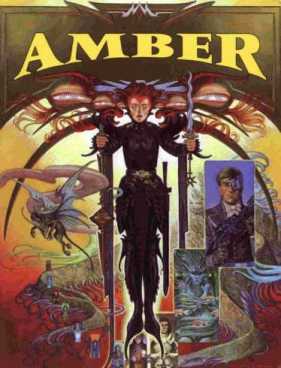
The Amber Diceless Roleplaying Game is a role-playing game created and written by Erick Wujcik, set in the fictional universe created by author Roger Zelazny for his Chronicles of Amber. The game is unusual in that no dice are used in resolving conflicts or player actions; instead a simple diceless system of comparative ability, and narrative description of the action by the players and gamemaster, is used to determine how situations are resolved.

The Great Pyramid of Giza is the largest Egyptian pyramid and the tomb of Fourth Dynasty pharaoh Khufu. Built in the early 26th century BC during a period of around 27 years, the pyramid is the oldest of the Seven Wonders of the Ancient World, and the only one to remain largely intact. It is the most famous monument of the Giza pyramid complex, in the Pyramid Fields of the Memphis and its Necropolis UNESCO World Heritage Site, in Giza, Egypt. It is at the most Northern end of the line of the 3 Pyramids of Giza.
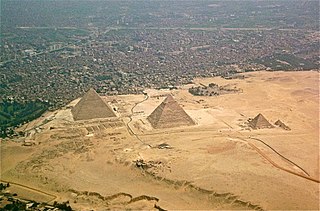
A pyramid is a structure whose outer surfaces are triangular and converge to a single step at the top, making the shape roughly a pyramid in the geometric sense. The base of a pyramid can be trilateral, quadrilateral, or of any polygon shape. As such, a pyramid has at least three outer triangular surfaces. The square pyramid, with a square base and four triangular outer surfaces, is a common version.

Steve Jackson Games (SJGames) is a game company, founded in 1980 by Steve Jackson, that creates and publishes role-playing, board, and card games, and the gaming magazine Pyramid.
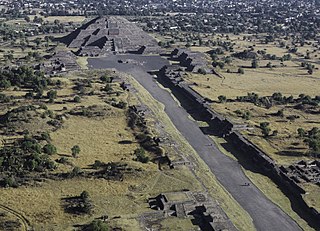
Teotihuacan is an ancient Mesoamerican city located in a sub-valley of the Valley of Mexico, which is located in the State of Mexico, 40 kilometers (25 mi) northeast of modern-day Mexico City. Teotihuacan is known today as the site of many of the most architecturally significant Mesoamerican pyramids built in the pre-Columbian Americas, namely the Pyramid of the Sun and the Pyramid of the Moon. At its zenith, perhaps in the first half of the first millennium, Teotihuacan was the largest city in the Americas, considered as the first advanced civilization on the North American continent, with a population estimated at 125,000 or more, making it at least the sixth-largest city in the world during its epoch.

A ziggurat is a type of massive structure built in ancient Mesopotamia. It has the form of a terraced compound of successively receding storeys or levels. Notable ziggurats include the Great Ziggurat of Ur near Nasiriyah, the Ziggurat of Aqar Quf near Baghdad, the now destroyed Etemenanki in Babylon, Chogha Zanbil in Khūzestān and Sialk Plus, Sumer in general. The Sumerians believed that the gods lived in the temple at the top of the Ziggurats, so only priests and other highly respected individuals could enter. Society offered them many things such as music, harvest, and creating devotional statues to live in the temple.

The pyramid of Djoser, sometimes called the Step Pyramid of Djoser, is an archaeological site in the Saqqara necropolis, Egypt, northwest of the ruins of Memphis. The 6-tier, 4-sided structure is the earliest colossal stone building in Egypt. It was built in the 27th century BC during the Third Dynasty for the burial of Pharaoh Djoser. The pyramid is the central feature of a vast mortuary complex in an enormous courtyard surrounded by ceremonial structures and decoration. Its architect was Imhotep, chancellor of the pharaoh and high priest of the god Ra.
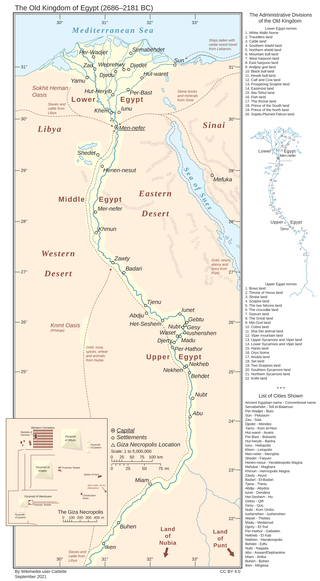
In ancient Egyptian history, the Old Kingdom is the period spanning c. 2700–2200 BC. It is also known as the "Age of the Pyramids" or the "Age of the Pyramid Builders", as it encompasses the reigns of the great pyramid-builders of the Fourth Dynasty, such as King Sneferu, who perfected the art of pyramid-building, and the kings Khufu, Khafre and Menkaure, who constructed the pyramids at Giza. Egypt attained its first sustained peak of civilization during the Old Kingdom, the first of three so-called "Kingdom" periods, which mark the high points of civilization in the lower Nile Valley.

A food pyramid is a representation of the optimal number of servings to be eaten each day from each of the basic food groups. The first pyramid was published in Sweden in 1974. The 1992 pyramid introduced by the United States Department of Agriculture (USDA) was called the "Food Guide Pyramid" or "Eating Right Pyramid". It was updated in 2005 to "MyPyramid", and then it was replaced by "MyPlate" in 2011.

Pathways into Darkness is a first-person shooter adventure video game developed and published by Bungie in 1993, for Macintosh personal computers. Players assume the role of a Special Forces soldier who must stop a powerful, godlike being from awakening and destroying the world. Players solve puzzles and defeat enemies to unlock parts of a pyramid where the god sleeps; the game's ending changes depending on player actions.
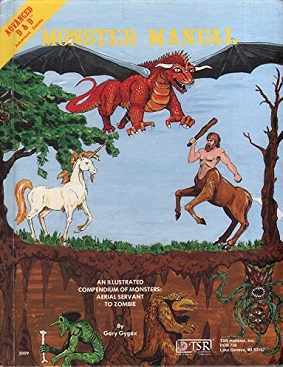
The Monster Manual is the primary bestiary sourcebook for monsters in the Dungeons & Dragons fantasy role-playing game, first published in 1977 by TSR. The Monster Manual was the first hardcover D&D book and includes monsters derived from mythology and folklore, as well as creatures created specifically for D&D. Creature descriptions include game-specific statistics, a brief description of its habits and habitats, and typically an image of the creature. Along with the Player's Handbook and Dungeon Master's Guide, the Monster Manual is one of the three "core rulebooks" in most editions of the D&D game. As such, new editions of the Monster Manual have been released for each edition of D&D. Due to the level of detail and illustration included in the 1977 release, the book was cited as a pivotal example of a new style of wargame books. Future editions would draw on various sources and act as a compendium of published monsters.
Jeff Grubb is an author who writes novels, short stories, and comics and a computer and role-playing game designer in the fantasy genre. Grubb worked on the Dragonlance campaign setting under Tracy Hickman, and the Forgotten Realms setting with Ed Greenwood. His written works include The Finder's Stone Trilogy, the Spelljammer and Jakandor campaign settings, and contributions to Dragonlance and the computer game Guild Wars Nightfall (2006).
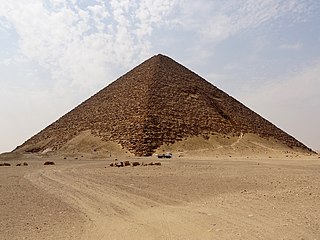
The Red Pyramid, also called the North Pyramid, is the largest of the pyramids located at the Dahshur necropolis in Cairo, Egypt. Named for the rusty reddish hue of its red limestone stones, it is also the third largest Egyptian pyramid, after those of Khufu and Khafre at Giza. It is also believed to be Egypt's first successful attempt at constructing a "true" smooth-sided pyramid. Local residents refer to the Red Pyramid as el-heram el-watwaat, meaning the Bat Pyramid.

Luxor Las Vegas is a 30-story casino hotel situated on the southern end of the Las Vegas Strip in Paradise, Nevada. The hotel is owned by Vici Properties and operated by MGM Resorts International and has a 120,000-square-foot (11,000 m2) casino with over 2,000 slot machines and 87 table games.

The Egyptian pyramids are ancient masonry structures located in Egypt. Sources cite at least 118 identified "Egyptian" pyramids. Approximately 80 pyramids were built within the Kingdom of Kush, now located in the modern country of Sudan. Of those located in modern Egypt, most were built as tombs for the country's pharaohs and their consorts during the Old and Middle Kingdom periods.

The Forgotten Realms Campaign Setting is a role-playing game sourcebook first published by TSR in 1987 for the first edition of the fantasy role-playing game Advanced Dungeons & Dragons that describes the campaign setting of the Forgotten Realms. It contains information on characters, locations and history. Various revised and updated editions have been produced over the years.

Stuart Alden Cook is an American bass guitarist, best known for his work in the rock band Creedence Clearwater Revival (CCR), for which he is a member of the Rock and Roll Hall of Fame.

The pyramid of Ahmose was built not as a tomb, but a cenotaph for pharaoh Ahmose I at the necropolis of Abydos, Egypt. It was the only royal pyramid built in this area. Today only a pile of rubble remains, reaching a height of about 10 m.

Chronomancer is a supplement to the 2nd edition of the Advanced Dungeons & Dragons fantasy role-playing game.
The Masquerade is a 1994 live action role-playing game published by White Wolf Publishing.